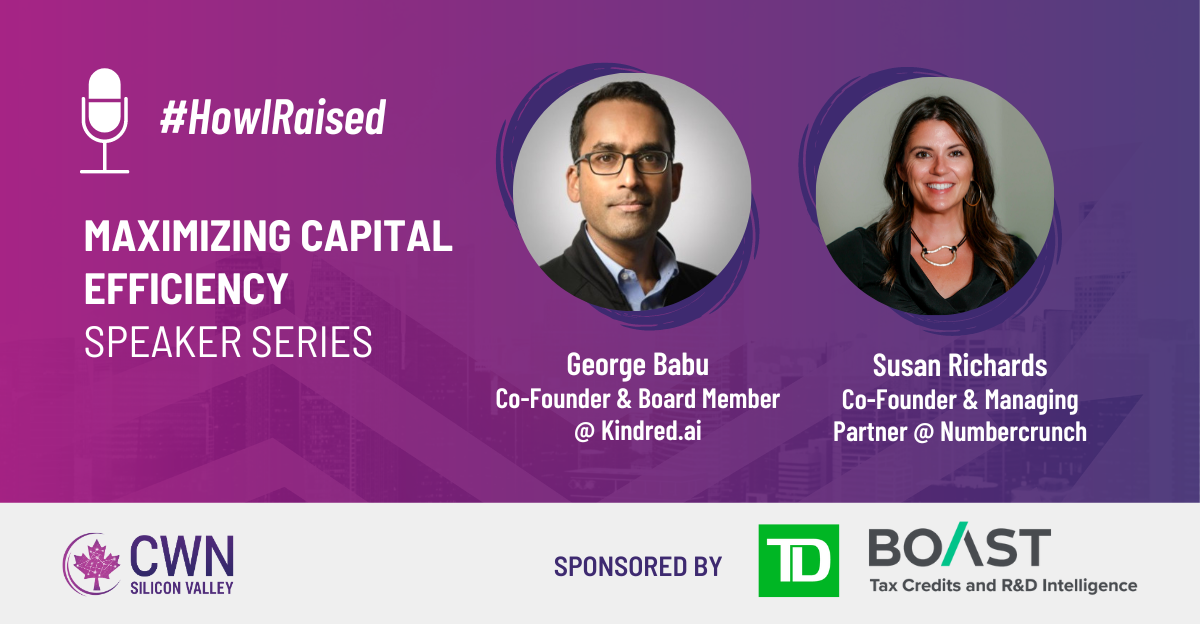#HowIRaised Series: Maximizing Capital Efficiency
Empowered by
This series is not about the “how I built this” story. We started How I Raised because we don’t talk enough about the capital and the hard story. The hard story is fundraising.
We’re giving you real examples of what not to do. And what to do. Where to draw the line. When it's okay to walk away -- when you need to walk away.
And when you lean in.
We captured learnings from a recent #HowIRaised event in Toronto, Hosted by TD and Boast, and wanted to share it with our community.
Thank you to Krystal Van Westerop, National Manager, Women in Enterprise at TD; George Babu, Co-founder of Kindred.ai; and Susan Richards, Co-Founder of numbercrunch for contributing to the conversation.
What are your thoughts on raising venture capital?
Despite the psychological challenges involved with raising capital, venture is great for the right time. Think of a venture-backed startup as security. Investors have different risk profiles and expectations. However, all funds want at least a 10x investment after 10 years.
At year 7-8 of the fund, they start to look for exits to return their LPs’ investments. Therefore, investors are incentivized to provide resources and help startups successfully exit.
Your talent pool grows with investment. When people find out who your backers are, they will trust the decisions of the previous investors. Banks are also then more likely to provide debt options. Leverage relationships that you make to generate further investment.
What are some strategies founders can use to get comfortable with learning key business metrics?
Talk confidently and invest the time required to understand your metrics. For example, there are 12 to 20 SAAS metrics that are easy to calculate. Start tracking metrics as soon as you have traction or revenue.
Projecting the path to profitability is critical. While founders aren’t expected to be profitable out of the gate, you are expected to project when profitability will happen.
Dedicate at least 1 hour to financial review and another to financial education each month.
Create a cheat sheet for when you are meeting investors to remember key metrics.
How do you straddle US vs Canadian networks? What are some differences on the investment side?
US investors expect high optimism. You need to sell the dream. Canadian investors are often more conservative. They have less capital to deploy so it makes sense. Often founders will look for lead investors in the US and then bring along investment at home.
Time again, we see founders told they are asking for too much from Canadian investors and too little on the US side. Most Silicon Valley VC investors will want to see startups raising at least 2M USD.
Tailor your approach for each investor by researching their background and interests. Your job as a founder is to bring money into the company. You can hire someone else to develop the product, but selling to customers and investors is your priority.
Due diligence is taking longer than it used to. Exploring other financing options is important. How is the landscape changing, and how should founders approach a relationship with their bank?
Look at different options i.e., SR&ED Tax Credits (and Financing)*NRC IRAP, Grants, Angel Investors, Venture Debt, and match the type of risk/return profile with that use of capital. For example, if you’re buying servers, you might use debt vs venture capital. Historically, a lot of founders in climate tech used venture financing for everything. A lot failed because the return didn’t match expectations. Therefore, a relationship with your banker is important.
When founders get busy, they often do not communicate enough with investors, banks, and employees. You want them on your side and to be successful. Spend dedicated time to provide them updates and be in touch.
Own your cool and believe that you are the coolest person they are meeting. People are looking for people to share their vision, dreams, and engage in interesting and fruitful conversations. The capital stack is complex and tricky. We can't all be VC-backed companies. We have strong financial institutions that can help with that.
Finally, reciprocity is important. Help open doors for investors and bankers by offering introductions to other founders. Ask, “Are there any ways you can help me, and I help you?”
*CWN’s partner, Boast, helps founders unlock millions in innovation funding. Get in touch with them here.
Boast’s Resources for Women-Owned Businesses
Boast helps companies easily capture more of their eligible R&D tax credits with its scalable, intelligent software and expert services. By removing the manual work and simplifying the process to access the SR&ED refund, Boast helps founders to extend their runway and improve their cash flow. Book a complimentary consultation here.
TD’s Resources For Women-Owned Businesses
At TD, we see the full picture – because our Women in Enterprise Bankers look deeper. We can help you navigate the unique opportunities and challenges of leading or owning a business by offering tailored financial advice, services, and solutions. Contact TD.WomenInEnterprise@td.com to learn more.Access More From The Canadian Women’s Network
Become a member of the Canadian Women’s Network to access more #HowIRaised events and participate in future conversations. Join 800+ women entrepreneurs and business leaders across Canada! Sign up here.



